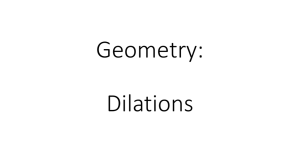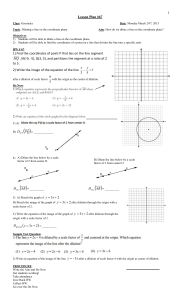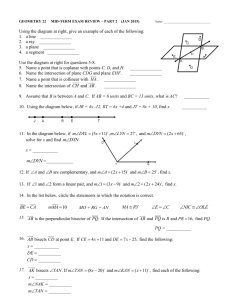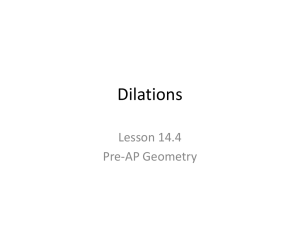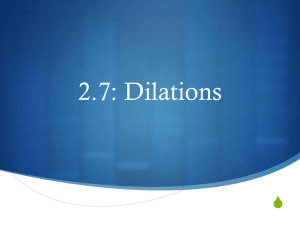Shoe Last Machining using Virtual Digitising
advertisement
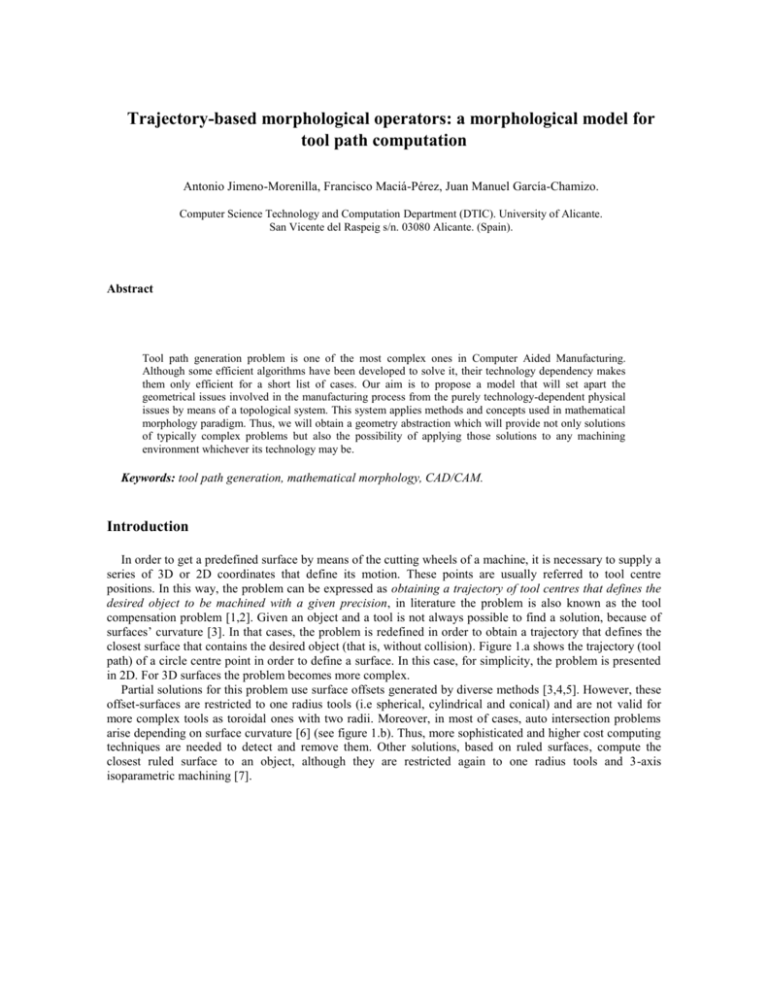
Trajectory-based morphological operators: a morphological model for tool path computation Antonio Jimeno-Morenilla, Francisco Maciá-Pérez, Juan Manuel García-Chamizo. Computer Science Technology and Computation Department (DTIC). University of Alicante. San Vicente del Raspeig s/n. 03080 Alicante. (Spain). Abstract Tool path generation problem is one of the most complex ones in Computer Aided Manufacturing. Although some efficient algorithms have been developed to solve it, their technology dependency makes them only efficient for a short list of cases. Our aim is to propose a model that will set apart the geometrical issues involved in the manufacturing process from the purely technology-dependent physical issues by means of a topological system. This system applies methods and concepts used in mathematical morphology paradigm. Thus, we will obtain a geometry abstraction which will provide not only solutions of typically complex problems but also the possibility of applying those solutions to any machining environment whichever its technology may be. Keywords: tool path generation, mathematical morphology, CAD/CAM. Introduction In order to get a predefined surface by means of the cutting wheels of a machine, it is necessary to supply a series of 3D or 2D coordinates that define its motion. These points are usually referred to tool centre positions. In this way, the problem can be expressed as obtaining a trajectory of tool centres that defines the desired object to be machined with a given precision, in literature the problem is also known as the tool compensation problem [1,2]. Given an object and a tool is not always possible to find a solution, because of surfaces’ curvature [3]. In that cases, the problem is redefined in order to obtain a trajectory that defines the closest surface that contains the desired object (that is, without collision). Figure 1.a shows the trajectory (tool path) of a circle centre point in order to define a surface. In this case, for simplicity, the problem is presented in 2D. For 3D surfaces the problem becomes more complex. Partial solutions for this problem use surface offsets generated by diverse methods [3,4,5]. However, these offset-surfaces are restricted to one radius tools (i.e spherical, cylindrical and conical) and are not valid for more complex tools as toroidal ones with two radii. Moreover, in most of cases, auto intersection problems arise depending on surface curvature [6] (see figure 1.b). Thus, more sophisticated and higher cost computing techniques are needed to detect and remove them. Other solutions, based on ruled surfaces, compute the closest ruled surface to an object, although they are restricted again to one radius tools and 3-axis isoparametric machining [7]. a c b a) b) Fig. 1. a) Tool compensated trajectory for part surface. Note that, due to surface curvature, machined surface will differ from the original without collision in a; b) compensated trajectory by means of surface offsetting. Autointersections in b and discontinuities in c will clash with part surface in shaded regions. The morphologic approach We are interested in defining the machining process itself, without technology considerations. That is, a machining process could be described as the definition of an object (the part surface) by means of another object (the tool). This idea is clearly related to a morphological operation, where the part surface could be represented as a set X, and the tool could be modeled by a structuring element B. In this way, we could look at figure 1.a and observe a morphologic dilation of the part surface using a circle as structuring element. The compensated trajectory corresponds to the dilation boundary. A similar idea was described in order to obtain pencil tracing trajectories. The process, called virtual digitizing [8], defines a tool movement over the part surface as a mechanical digitizer does, virtually touching an object. The virtual digitizing method, restricted to z-maps representations and one radius tools, was extended to NURBS surfaces used in shoe last machining [9]. Presented in this paper there is a generalization of the virtual digitizing method, based on mathematical morphology. The morphologic paradigm is based on set theory. Thus, most operations are indeterminist, defined over elements of a set. For machining purposes, our new morphologic operations will be restricted to support an order. The order of the morphology operation is important because will represent the tool trajectory. Another important consideration is that we are interested only in the boundary of operations, since tool always attacks the material from outside in a mechanizing process. Some efficient computation methods for morphology operations use the boundary representation as well [10,11]. Instant basic operations A morphological operation will be divided into a sequence of unitary or basic operations. This sequence will guarantee the resulting order of the whole operation. Since every basic operation will correspond to a particular position of a tool along a trajectory that is performed during a period of time, we call them instant basic operations. Let define the instant basic operator k for the instant k as follows: X k B p R n : p distv B, X k v Bp X (1) where X is the target object, B the structuring element, k represents an homogeneous transformation matrix in Rn+1 xRn+1 obtained for a particular k real value; and distv is the Euclidean distance between the structuring element and the transformation of the X object (post-multiplying every element of the X set by the homogeneous transformation matrix k ) computed in the direction addressed by the v vector. In other words, this operation obtains the structuring element centre when it touches the X boundary following the v direction. The concept is illustrated in figure 2. In that example, an object X is transformed applying a 2D rotation matrix over its centre c. For this case, k could represent the number of degrees in that transformation matrix, so its values are in the 0,2 range. Once the object is transformed (figure 2.c), the distance between B and X in the v direction is applied to the B centre in order to obtain the result of the instant basic operation (that is, the p point). For different and ordered real k values (using the < relation in R), we will obtain a new set of structuring element centres that touch the X boundary. These centres will be also ordered in the geometric space due to the use of different rotation matrixes. n (k ) v B c v c X B a) v X c p B X b) c) ) Fig. 2. Geometric description of an instant basic dilation. a) Initial position. b) X transformation. c) Distance computing. Trajectory-based morphological operators In this section, we apply the instant basic operator in order to achieve a whole morphologic operation. We are interested in defining one fundamental operation in the morphologic paradigm: the dilation. As commented above, the goal is obtain only the boundary of these operations for machining purposes. Dilation Descriptively, this operation is classically defined as the place of centre positions of the structuring element B when it touches an X set [12] (Eq. 2). X B x R n , Bx X (2) In our context, we are interested only in dilation boundary, which is the place of centre positions that touch the X boundary (Eq. 3), called Fr. Fr ( X B) x R n , Bx X Bx In( X ) (3) Where In(X) represents the inner part of a set, that is, X without periphery. Derived from Eq. (1), we define the instant basic dilation, which defines a centre position touching the boundary of a set X, but from outside: X k B p R n : p distv B, X k v Bp X In( X ) (4) Using the instant basic dilation, we define the trajectory-based dilation as the set of points resulting from the repeated and ordered application of the instant basic dilation, for the normalized k range [0..1] (Eq. 5). Trajectory, defined by k , must assure the full round over the object in the normalized range. Since, only boundary points are computed, trajectory-based dilation does not operate on objects with holes. Assuming compact sets, it is clear the equivalence between the frontier of the classical dilation (Eq.3) and the trajectorybased one (Eq. 5). X B k[0..1] ( X ( k ) B) y R n : By X By In( X ) (5) Trajectory-based dilation, by means of homogeneous transformations which are compounded of translations and rotations, could orientate the structuring element in any position on the object boundary, this feature is not supported by classical dilations where structuring element remains in the same position, but it is necessary when it is used for machining purposes (specially in 5-axis machining for tool orientation). Experiments In this section, we present some experiments in order to test both correctness and goodness of trajectory-based operations. The first one compares classical dilation versus its trajectory-based version. In table 1 we show the algorithms used in tests. As assumptions, figures must be compact, that is, without holes. The selected trajectory was a simple rotation around the object. MM1 dilation 1: For pX do 2: For eSE do 3: Image(p+e)=1; 4: Endfor 5: Endfor MM2 dilation 1: For pFr(X) do 2: For eSE do 3: Image(p+e)=1; 4: Endfor 5: Endfor Trajectory-based dilation 1: k=0 2: While k<=1 do 3: MinDistance= 4: For pFr(X) do 5: p’=Rotate(p,k*360º) 6: d =dv(p’, x2+y2=r2) // Distance point/circle in x dir. 7: If d<MinDistance then MinDistance=d Endif 8: Endfor 9: CentreEE=ComputeCentre(MinDistance,k) 10: AddTrajectory(CentreEE) 11: Increment(k) 12: Endwhile Table 1. Pseudo-code used for the 2D experiments. Figure 3 shows an example of dilation and erosion. The black part correspond to the classical operation, the frontier is computed by means of the associated trajectory-based operator. morphologic operation frontiers Original object boudaries Fig. 3. Experiment in two dimensions. On the left, a morphologic dilation. On the right, a morphologic erosion. The structuring element was a circle of 20 pixels in radius. The algorithm called MM1 corresponds to a classic morphological dilation, while the MM2 corresponds to that classical version operating only on the boundary of the object. The trajectory-based version was called MTD for the experiments. Time results are showed in figure 4 for a dilation using a circle as structuring element. They were obtained on a Windows® based platform using a Pentium® II processor. Since MTD version uses an analytic formula to compute the distance between a point and the structuring element, the results demonstrates a practically independence of the structuring element size for this algorithm. They also show a low linear dependency on the object size, although due to its bigger complexity, obtains worse time results than the MM2 algorithm. Due to the fact that trajectory-based operator were defined according to machining process specifications, they present some restrictions in order to apply them to images; however, they could be indicated for high density images. 2500 MM1 MM2 MTD 1500 1000 500 0 0 10000 20000 30000 40000 Structuring element size (pixels) (radius=1,5,20,40,60,100) time (ms) time (ms) 2000 500 450 400 350 300 250 200 150 100 50 0 MM1 MM2 MTD 0 20000 40000 60000 Object size (pixels) Fig. 4. Time results for 2D experiments. On the left, time versus structuring element size. On the right, time versus object size for a 20 pixel-in-radius structuring element. Finally, we present some images related to experiments used in shoe last machining [9]. A trajectory-based dilation of a 3D object (the shoe last), using a 3D torus as structuring element (a toroidal tool) is presented in figure 5. The proposed algorithm in figure 4 has been successfully implemented in a commercial CAD/CAM system specialized in shoe last making [13]. a) b) c) Fig. 5. Experiment in shoe last machining: a) a woody hand-made shoe last, and a polyethylene mechanized one, b) a 3D dilation of shoe last using a 3D torus as structuring element, c) computed trajectory for a turning lathe machine by means of trajectory-based dilation. Conclusions and Discussions In the paper, we develop, through trajectory-based morphological operations, a topological system resulting from applying the conventional morphological model to which the feature of primitives ordering has been added. The proposed operations account for the problems present in the manufacturing processes derived from the tool machining. The implementation of the new morphological primitives, now machining operations, performed in the actual manufacturing process for validation. A trajectory-based operation has been implemented in existing architectures, offers good results in real machining systems, and avoids the problem of tool collision by its own definition. Other trajectory-based operations as erosion, openings, closures, and so are introduced in [14]. We are interested in demonstrating their utility and efficiency for surface reconstruction or trajectory optimization; however, other versions of morphological operations (top hat, skeletons) are still under object of study. The benefit of trajectory operators in image domain is another question to answer. Independency from structuring element size could be interesting to apply morphological operations on high definition images or 3D image reconstruction. References [1] Faux, I. D., Pratt, M.J. Computational Geometry for Design and Manufacture. Ellis Horwood, 1979. [2] Farin, G. Curves and Surfaces for Computer Aided Geometric Design. A Practical Guide. Academic Press Inc., 1993. [3] Wang, Y. Intersection of offsets of parametric surfaces. Computer Aided Geometric Design, vol. 13, pp.453-465, 1996. [4] Choi, B. K. Surface Modeling for CAD/CAM. Elsevier Science Publishers, pp. 263-272, 1991. [5] Held, M. Voronoi Diagrams and Offset Curves of Curvilinear Polygons. Computer-Aided Design, vol. 30, no. 4, pp. 287-300, 1998. [6] Wallner, J., Sakkalis, T. Self-intersections of offset curves and surfaces. Journal of Shape Modeling, no 7, pp. 1-21, 2001. [7] Elber, G., Fish, R. 5-Axis Freeform surface milling using piecewise surface approximation. ASME Journal of Manufacturing Science and Engineering, vol. 119, no. 3, pp. 383-387, 1997. [8] Jung, W., Park, Y. et al. Pencil curve tracing using virtual digitizing. Proceedings of IFIP CAPE conference, pp. 97104, 1991. [9] Jimeno, A., García-Chamizo, J. M., Salas, P. Shoe Last machining using Virtual Digitising. International Journal of Advanced Manufacturing Technology, vol. 17, no. 10, pp. 744-750, 2001. [10] Vincent, L. Morphological transformations of binary images with arbitrary structuring elements. Image Processing, vol. 22, no. 1, pp. 3-23, January 1991. [11] Nikopoulos, N., Pitas, I. An Efficient Algorithm for 3D Binary Morphological Transformations with 3D Structuring Elements of Arbitrary Size and Shape. Proceedings of 1997 IEEE Workshop on Nonlinear Signal and Image Processing (NSIP'97),1997. [12] Serra, J. Image Analysis and Mathematical Morphology. Academic Press, London, 1982. [13] Jimeno, A, García J., Salas F. Shoe lasts and computer systems. (Spanish) Tecnología del Calzado. November 1999. [14] Jimeno, A. Topological modeling of the machining process. Tool compensation application. (Spanish) PhD Thesis. Dept. DTIC, University of Alicante (Spain), July 2003.

